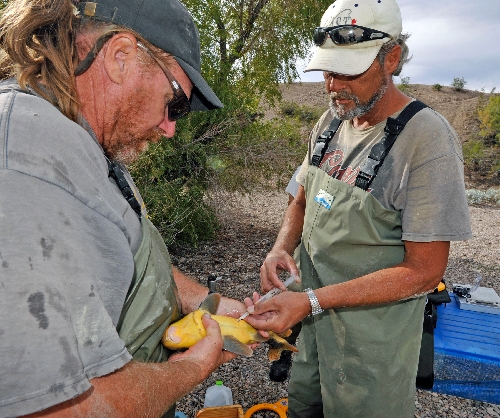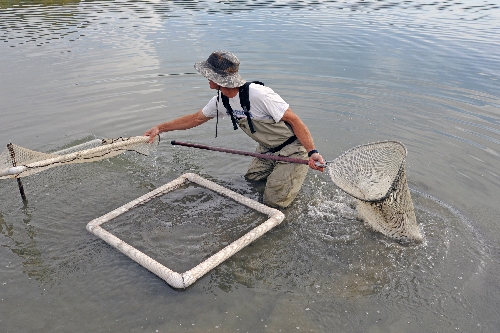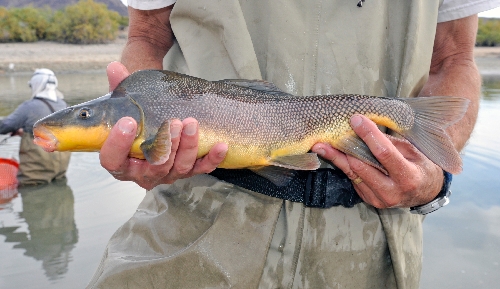Without hatcheries, Colorado River razorback sucker might disappear
In a shrinking pond near the Arizona shore of Lake Mohave, men in waders sweat and slog their way through knee-deep mud, netting endangered fish and clearing weeds.
If biologists can't save the Colorado River's razorback sucker, it won't be for a lack of trying.
For more than 20 years, researchers have been studying the distinctive river fish and trying to figure out the best way to boost its numbers.
The current strategy involves scooping up thousands of fish larvae early each year, as soon as they hatch, and raising them in predator-free ponds, hatcheries and other safe havens away from the Colorado.
Once they grow to about a foot long, they are released back into the river system, where researchers hope the extra size and experience will give them a fighting chance against striped bass and other large, nonnative fish.
"They're running this gauntlet as they go," said John Swett, the biologist who heads the U.S. Bureau of Reclamation's efforts to save the sucker and a host of other native species on the Colorado River. "You say good luck to them and hope you see them on a spawning bed next year."
Chances are, though, that most of these razorbacks the government has spent years raising will be gobbled up long before they can reproduce.
DAMMED AND DEFENSELESS
The brown and yellow fish with the bony ridge above its head used to be found throughout the Colorado River system, where it grew to 3 feet long and lived as long as 50 years.
Today it is limited to a few remnant populations, mostly downstream from the Grand Canyon. Fewer than 10,000 are thought to survive in the wild. Roughly 4,000 of those live in Lake Mohave, which now serves as the cradle of life for the species.
It's unclear whether the fish can be saved.
Before the Colorado was dammed and parceled out to farms and cities hundreds of miles from its banks, it tumbled from the Rocky Mountains to the Gulf of California with an irregularity bordering on schizophrenia. It would jump its banks one year and nearly run dry the next, with silt-laden water the clarity of chocolate milk.
"Too thin to plow, too thick to drink - that's what the old Mormon settlers said about it," Swett said.
The razorback sucker was born into this opaque world, so it never really learned how to hide.
When the dams went up and the clear, blue reservoirs behind them were stocked with game fish, the sucker was an easy meal still behaving as if it was invisible.
The crystalline water also proved devastating during spawning season, when the suckers would leave their fertilized eggs unguarded to be vacuumed up in plain sight by carp and other nonnative fish.
As Reclamation fisheries biologist Jeff Lantow put it: "They spawn so early in the year, they're the first food source out there."
RAISING RAZORBACKS
It's a sunny Thursday in early November, and the water in Lake Mohave is as low as it has been in at least a decade.
The narrow reservoir formed by Davis Dam near Laughlin generally dips in midautumn, but federal regulators have pushed it even lower this year - enough to shut down the lake's boat launch ramps for more than a week - all to help save the razorback sucker.
The Bureau of Reclamation and its conservation partners maintain six fish rearing ponds, known as backwaters, along Lake Mohave, and the ponds need to be drained and cleaned out every five or six years.
On this day, a six-man crew is working on the largest of the backwaters at Yuma Cove, roughly two miles northeast of the Cottonwood Cove marina.
The site is remote and the work days are long, so the men don't go home at night. They pitch tents and camp near the shore.
In a day or two, the pond will dry out completely, so the crew is busy netting the last few fish and moving them out.
Every sucker that researchers raise or capture is implanted with a tracking device known as a pit tag, which is the size of a Tic Tac and encoded with a unique, 10-digit number.
"It's kind of like naming your fish," Swett said. "When we catch them again, we know whether they are Ethel or Fred."
Swett and company have been marking fish since 1990. Occasionally, the pit tags are found in the bellies of striped bass and other fish. More often than not, the tags and the suckers they belong to are never seen again.
Razorback larvae are less than half an inch long when they hatch, but they are easy enough to catch. Biologists go out on the lake at night, stick light bulbs in the water to attract the fish and scoop them up in dip nets like the ones used in pet shops or home aquariums.
Raising a sucker to the target release length of 300 millimeters can take as long as four years, depending on the fish, what it's fed and where it's kept.
Before being returned to the wild, each fish from the pond at Yuma Cove is scanned with a wand to check for a pit tag and injected with one if need be. Then the fish is weighed and examined to determine its gender, relative health and "breeding condition," which is pretty much what it sounds like.
After that, the razorbacks are released without ceremony back into Lake Mohave. One of the workers simply carries a five-gallon bucket of fish down the hill from the pond and empties it into the reservoir, where danger lurks just offshore.
Swett said a few striped bass seem to hang around waiting for the buckets of suckers. Even the biggest razorbacks aren't safe from stripers that can weigh up to 60 pounds.
"They'll eat two or three of them," said biological technician Randy Thomas before he headed back to the pond with an empty bucket.
TROUBLE SPOTTED
A sucker worth saving?
The razorback seemed to be doing fine as recently as the late 1980s, when counts in the lower reaches of the Colorado pegged the population at roughly 60,000. But a closer look revealed serious trouble ahead: All the fish in the system were larger, older specimens. Young fish were nowhere to be found.
Biologists knew then they were looking at a dead fish swimming. If something wasn't done quickly, the existing population would crash, maybe for good.
The sucker was added to the endangered species list in 1991, and its remaining range was designated as critical habitat in 1994.
It is now one of 31 native species protected under the Lower Colorado River Multi-Species Conservation Program, a 2005 agreement among federal agencies and water users along the river, including the Southern Nevada Water Authority.
The program's built-in target for the razorback sucker calls for 660,000 to be released into the river below Davis Dam by the year 2055.
But the real mission is to learn enough about the fish to improve its overall odds of survival, said Eric Volkman, manager of Reclamation's fisheries group for the lower Colorado River. Otherwise, no amount of restocking will ever lead to recovery. No amount of human help will ever truly save the sucker.
Some wonder if it's worth the trouble.
Swett said he gets such questions pretty regularly at public meetings. Why spend so much time and money just to save a "trash fish"? You can't even eat it, can you?
The simple answer is that federal law requires protection for the sucker. But Swett also feels a certain obligation to the species, since its world was turned upside down in the name of human progress.
It would be one thing if the changes to the river were occurring naturally, he said. "But this has happened rather quickly, and we caused it. I think we have some responsibility to do something about that."
Volkman said there may be more at stake than we realize.
After all, natural systems are impossibly complex, and if we don't fully understand how they work, we can't predict what might cause them to break down. A single extinction could lead to many more.
"It seems prideful that we can decide to let something go away and not think there will be other negative consequences to that," Volkman said.
Contact reporter Henry Brean at hbrean@reviewjournal.com or 702-383-0350.




















